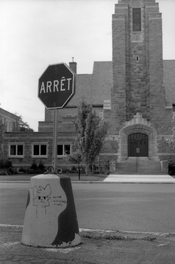Dear community,
I really like the industrial incarnation of Patrick Gainer's PC-TEA developer that is Flic Film's Black, White & Green (BW&G hereafter) because it's very consistent and widely available in Canada.
However I also like trying new and/or exotic film, and Flic Film's suggestion for unknown dev times is to use "whats used for Kodak D-76 1:2." If you've been to the massive dev chart, you'll know that 1+2 is a seldom used dilution, so I made a more useful rule of thumb to calculate better starting points for BW&G development at the recommended dilution of 1+49. This was part of a much larger project to help the photographic community that is on hold for now, because a PhD in chemistry is plenty of work already.
So it happens that D-76 1+1 dev times can be correlated even more successfully with BW&G times such that if we take the D-76 1+1 time (in decimal in case of a not-round number of minutes), multiply it by 1.145 and add 0.32, we obtain a strong educated guess at the dev time in BW&G 1+49.
TL;DR (D76_1+1time * 1.145) + 0.32 yields a good starting point.
I have used this equation successfully to predict new development times for:
I hope this first post of mine helps those who enjoy BW&G to test it out with all sorts of films since D-76 has dev times for even very old films (although beware it's a developer that can promote fog on expired films). If I have it my way this won't be my last post as I have plans for what to do after I get my degree that may or may not involve reducing agents.
- Jason, the little ghost chilling in-between the grains of silver
P.S. If you're someone who sees what bigger project this could have been a part of, please get in touch and I'll do what I can to help create what I lack time for.
I really like the industrial incarnation of Patrick Gainer's PC-TEA developer that is Flic Film's Black, White & Green (BW&G hereafter) because it's very consistent and widely available in Canada.
However I also like trying new and/or exotic film, and Flic Film's suggestion for unknown dev times is to use "whats used for Kodak D-76 1:2." If you've been to the massive dev chart, you'll know that 1+2 is a seldom used dilution, so I made a more useful rule of thumb to calculate better starting points for BW&G development at the recommended dilution of 1+49. This was part of a much larger project to help the photographic community that is on hold for now, because a PhD in chemistry is plenty of work already.
So it happens that D-76 1+1 dev times can be correlated even more successfully with BW&G times such that if we take the D-76 1+1 time (in decimal in case of a not-round number of minutes), multiply it by 1.145 and add 0.32, we obtain a strong educated guess at the dev time in BW&G 1+49.
TL;DR (D76_1+1time * 1.145) + 0.32 yields a good starting point.
I have used this equation successfully to predict new development times for:
- Catlabs X 320 Pro, at 13:00
- Svema Foto 400, at 23:15 with great success
- Panatomic-X, at 10:30 also with great result but I mean this is Pan-X we're talking about-
- Lucky SHD400, at 12:30 (this one might need a bit of tweaking but now I realize it's not really a 400 ISO film)
- and thanks to this forum's very own @Andrew O'Neill Ferrania P33 (which came out a little thin at 13:00 because I couldn't indicate the agitation pattern of 10 seconds per minute, in time, See his video here ).
I hope this first post of mine helps those who enjoy BW&G to test it out with all sorts of films since D-76 has dev times for even very old films (although beware it's a developer that can promote fog on expired films). If I have it my way this won't be my last post as I have plans for what to do after I get my degree that may or may not involve reducing agents.
- Jason, the little ghost chilling in-between the grains of silver
P.S. If you're someone who sees what bigger project this could have been a part of, please get in touch and I'll do what I can to help create what I lack time for.
Attachments
Last edited:






